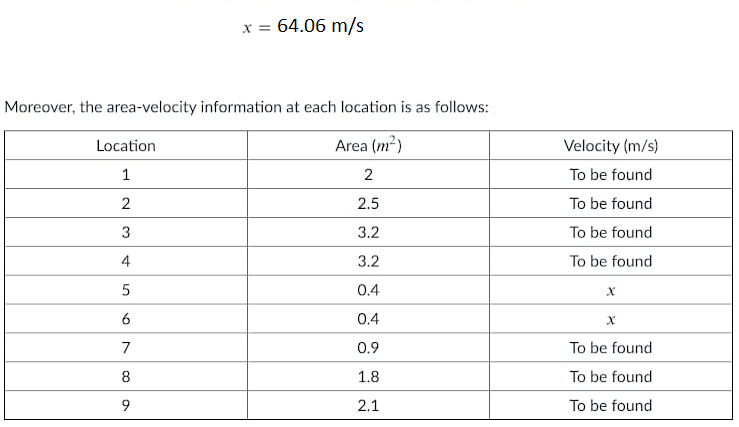Air flows through a closed-circuit wind tunnel shown in Figure below at standard conditions through the test section [between sections (5) and (6)] with a velocity of x m/s. The flow is driven by a fan that essentially increases the static pressure by the amount p1 – p, that is needed to overcome the head losses experienced by the fluid as it flows around the circuit. Estimate the value of p - py and the horsepower supplied to the fluid by the fan. Vs = x m/s %3D (4) (5) (6) (7) Test section (3) Flow-straightening screens (8) Q (1). (9) V Automatic Hidden Arrow XA
Air flows through a closed-circuit wind tunnel shown in Figure below at standard conditions through the test section [between sections (5) and (6)] with a velocity of x m/s. The flow is driven by a fan that essentially increases the static pressure by the amount p1 – p, that is needed to overcome the head losses experienced by the fluid as it flows around the circuit. Estimate the value of p - py and the horsepower supplied to the fluid by the fan. Vs = x m/s %3D (4) (5) (6) (7) Test section (3) Flow-straightening screens (8) Q (1). (9) V Automatic Hidden Arrow XA
Elements Of Electromagnetics
7th Edition
ISBN:9780190698614
Author:Sadiku, Matthew N. O.
Publisher:Sadiku, Matthew N. O.
ChapterMA: Math Assessment
Section: Chapter Questions
Problem 1.1MA
Related questions
Question
![Review Questions
Air flows through a closed-circuit wind tunnel shown in Figure below at standard conditions through the
test section [between sections (5) and (6)] with a velocity of x m/s. The flow is driven by a fan that
essentially increases the static pressure by the amount p¡ – p, that is needed to overcome the head losses
experienced by the fluid as it flows around the circuit.
Estimate the value of p, – p, and the horsepower supplied to the fluid by the fan.
- P9
Vs = x m/s
(5)
(6)
(7)
Test section
Flow-straightening
(3)
screens
(8)
Q (1)
(9)
V Automatic
(2)
Hidden
Arrow
Pen
Fan](/v2/_next/image?url=https%3A%2F%2Fcontent.bartleby.com%2Fqna-images%2Fquestion%2Fe6b99d55-7ade-4e69-8dc2-8e23c882a07c%2F7d96ac73-3755-41c9-9fcc-c74633b5dcc1%2Fkiig17lx_processed.jpeg&w=3840&q=75)
Transcribed Image Text:Review Questions
Air flows through a closed-circuit wind tunnel shown in Figure below at standard conditions through the
test section [between sections (5) and (6)] with a velocity of x m/s. The flow is driven by a fan that
essentially increases the static pressure by the amount p¡ – p, that is needed to overcome the head losses
experienced by the fluid as it flows around the circuit.
Estimate the value of p, – p, and the horsepower supplied to the fluid by the fan.
- P9
Vs = x m/s
(5)
(6)
(7)
Test section
Flow-straightening
(3)
screens
(8)
Q (1)
(9)
V Automatic
(2)
Hidden
Arrow
Pen
Fan

Transcribed Image Text:x = 64.06 m/s
Moreover, the area-velocity information at each location is as follows:
Location
Area (m?)
Velocity (m/s)
1
2
To be found
2
2.5
To be found
3
3.2
To be found
4
3.2
To be found
0.4
0.4
7
0.9
To be found
8
1.8
To be found
2.1
To be found
6.
Expert Solution
This question has been solved!
Explore an expertly crafted, step-by-step solution for a thorough understanding of key concepts.
This is a popular solution!
Trending now
This is a popular solution!
Step by step
Solved in 5 steps

Knowledge Booster
Learn more about
Need a deep-dive on the concept behind this application? Look no further. Learn more about this topic, mechanical-engineering and related others by exploring similar questions and additional content below.Recommended textbooks for you

Elements Of Electromagnetics
Mechanical Engineering
ISBN:
9780190698614
Author:
Sadiku, Matthew N. O.
Publisher:
Oxford University Press

Mechanics of Materials (10th Edition)
Mechanical Engineering
ISBN:
9780134319650
Author:
Russell C. Hibbeler
Publisher:
PEARSON

Thermodynamics: An Engineering Approach
Mechanical Engineering
ISBN:
9781259822674
Author:
Yunus A. Cengel Dr., Michael A. Boles
Publisher:
McGraw-Hill Education

Elements Of Electromagnetics
Mechanical Engineering
ISBN:
9780190698614
Author:
Sadiku, Matthew N. O.
Publisher:
Oxford University Press

Mechanics of Materials (10th Edition)
Mechanical Engineering
ISBN:
9780134319650
Author:
Russell C. Hibbeler
Publisher:
PEARSON

Thermodynamics: An Engineering Approach
Mechanical Engineering
ISBN:
9781259822674
Author:
Yunus A. Cengel Dr., Michael A. Boles
Publisher:
McGraw-Hill Education

Control Systems Engineering
Mechanical Engineering
ISBN:
9781118170519
Author:
Norman S. Nise
Publisher:
WILEY

Mechanics of Materials (MindTap Course List)
Mechanical Engineering
ISBN:
9781337093347
Author:
Barry J. Goodno, James M. Gere
Publisher:
Cengage Learning

Engineering Mechanics: Statics
Mechanical Engineering
ISBN:
9781118807330
Author:
James L. Meriam, L. G. Kraige, J. N. Bolton
Publisher:
WILEY